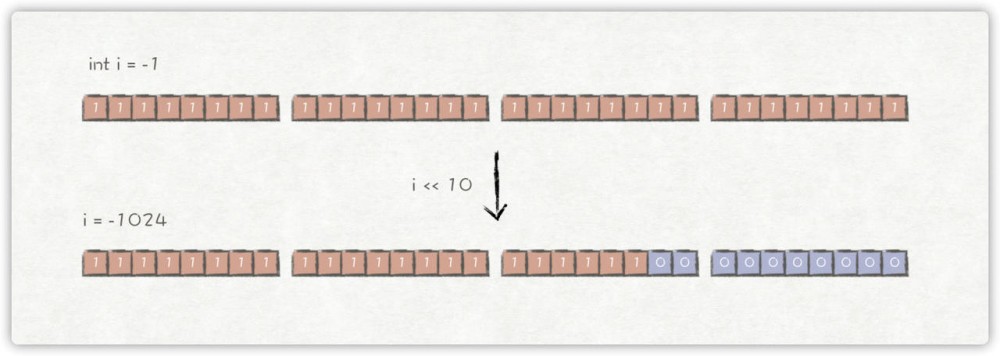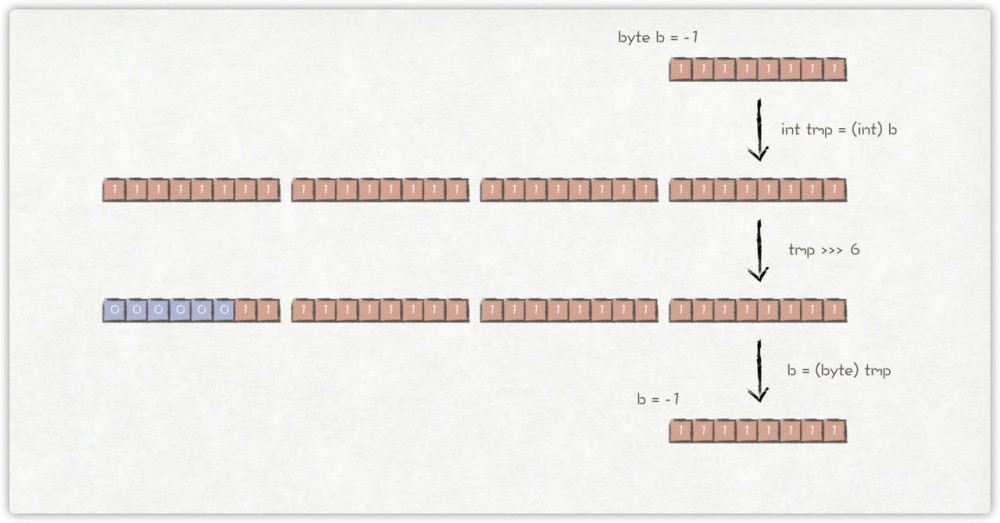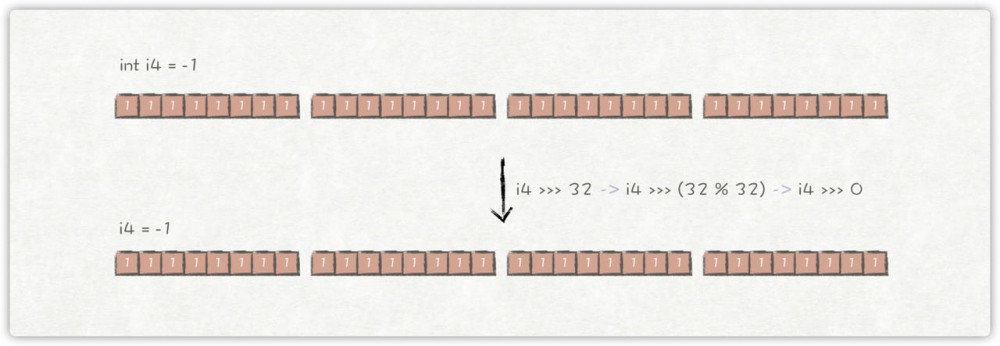彻底弄懂Java的移位操作符
前言
对于 移位操作符 ,很多人既感到熟悉,又感到陌生。熟悉是因为移位操作符是最基本的操作符之一,几乎每种编程语言都包含这一操作符;陌生是因为除非是追求极致性能等罕见场景,否则也很难用得上它。打开JDK源码,你会发现移位操作符的身影极为常见,弄清楚它的用法,对阅读源码很有帮助。
移位操作是把数据看作是二进制数,然后将其向左或向右移动若干位的运算。在Java编程语言中,移位操作符包含三种,分别是 << (左移)、 >> (带符号右移)和 >>> (无符号右移),这三种操作符都只能作用于 long 、 int 、 short 、 byte 、 char 这四种基本的整型类型上。
左移操作符 <<
左移操作符 << 是将数据转换成二进制数后, 向左移若干位,高位丢弃,低位补零 。看如下例子:
public static void main(String[] args) {
int i = -1;
System.out.println("Before << , i's value is " + i);
System.out.println("i's binary string is " + Integer.toBinaryString(i));
i <<= 10;
System.out.println("After << , i's value is " + i);
System.out.println("i's binary string is " + Integer.toBinaryString(i));
}
复制代码
Java的 int 占32位,因此对 i = -1 转换成二进制数,然后左移10位,其结果是左边高10位丢弃,右边低10位补 0 ,再转换为十进制,得到 i = -1024 的结果。

因此,上述例子的输出结果为:
Before << , i's value is -1 i's binary string is 11111111111111111111111111111111 After << , i's value is -1024 i's binary string is 11111111111111111111110000000000 复制代码
带符号右移操作符 >>
众所周知,Java中整型表示负数时,最高位为符号位,正数为 0 ,负数为 1 。 >> 是带符号的右移操作符,将数据转换成二进制数后, 向右移若干位,高位补符号位,低位丢弃 。对于正数作右移操作时,具体体现为高位补 0 ;负数则补 1 。看如下例子:
public static void main(String[] args) {
// 对正数进行右移操作
int i1 = 4992;
System.out.println("Before >> , i1's value is " + i1);
System.out.println("i1's binary string is " + Integer.toBinaryString(i1));
i1 >>= 10;
System.out.println("After >> , i1's value is " + i1);
System.out.println("i1's binary string is " + Integer.toBinaryString(i1));
// 对负数进行右移操作
int i2 = -4992;
System.out.println("Before >> , i2's value is " + i2);
System.out.println("i2's binary string is " + Integer.toBinaryString(i2));
i2 >>= 10;
System.out.println("After >> , i2's value is " + i2);
System.out.println("i2's binary string is " + Integer.toBinaryString(i2));
}
复制代码
例子中, i1 = 4992 转换成二进制数,右移10位,其结果是左边高10位补 0 ,右边低10位丢弃,再转换为十进制,得到 i1 = 4 的结果。同理, i2 = -4992 ,右移10位,左边高10位补 1 ,右边低10位丢弃,得到 i2 = -5 的结果。

因此,上述例子的输出结果为:
Before >> , i1's value is 4992 i1's binary string is 1001110000000 After >> , i1's value is 4 i1's binary string is 100 Before >> , i2's value is -4992 i2's binary string is 11111111111111111110110010000000 After >> , i2's value is -5 i2's binary string is 11111111111111111111111111111011 复制代码
无符号右移操作符 >>>
无符号右移操作符 >>> 与 >> 类似,都是将数据转换为二进制数后右移若干位,不同之处在于,不论负数与否,结果都是 高位补零,低位丢弃 。看如下例子:
public static void main(String[] args) {
int i3 = -4992;
System.out.println("Before >>> , i3's value is " + i3);
System.out.println("i3's binary string is " + Integer.toBinaryString(i3));
i3 >>>= 10;
System.out.println("After >>> , i3's value is " + i3);
System.out.println("i3's binary string is " + Integer.toBinaryString(i3));
}
复制代码
同样对 i3 = -4992 进行操作,转换成二进制数后,右移10位,其结果为左边高10位补 0 ,右边低10位丢弃,再转换成十进制,得到 i3 = 4194299 的结果。

因此,上述例子的输出结果为:
Before >>> , i3's value is -4992 i3's binary string is 11111111111111111110110010000000 After >>> , i3's value is 4194299 i3's binary string is 1111111111111111111011 复制代码
真的懂了吗?
对 short、byte、char 的移位操作
再看如下例子:
public static void main(String[] args) {
byte b = -1;
System.out.println("Before >> , b's value is " + b);
System.out.println("b's binary string is " + Integer.toBinaryString(b));
b >>>= 6;
System.out.println("After >> , b's value is " + b);
System.out.println("b's binary string is " + Integer.toBinaryString(b));
}
复制代码
Java的 byte 占8位,按照前面讲述的原理,对 b = -1 转换为二进制数后,右移6位,左边高6位补 0 ,右边低位丢弃,其结果应该是 b = 3 。

真的这样吗?我们看一下例子运行的结果:
Before >> , b's value is -1 b's binary string is 11111111111111111111111111111111 After >> , b's value is -1 b's binary string is 11111111111111111111111111111111 复制代码
运行结果与我们预期的结果不对!
原来,Java在处理 byte 、 short 、 char 的移位操作前,会 先将其转型成 int 类型,然后在进行操作 !特别地,当对这三者使用 <<= 、 >>= 和 >>>= 时,其实是得到对移位后的 int 进行低位截断后的结果!对例子改动一下进行验证:
public static void main(String[] args) {
byte b = -1;
System.out.println("Before >> , b's value is " + b);
System.out.println("b's binary string is " + Integer.toBinaryString(b));
System.out.println("After >> , b's value is " + (b >>> 6));
System.out.println("b's binary string is " + Integer.toBinaryString(b >>> 6));
}
复制代码
在该例子中,没有使用 >>>= 对 b 进行再赋值,而是直接将 b >>> 6 进行输出(需要注意的是, b >>> 6 的结果为 int 类型),其输出如下:
Before >> , b's value is -1 b's binary string is 11111111111111111111111111111111 After >> , b's value is 67108863 b's binary string is 11111111111111111111111111 复制代码
因此,第一个例子中实际的运算过程应该是这样:

对于 short 和 char 的移位操作原理也一样,读者可以自行进行实验验证。
如果移位的位数超过数值所占有的位数会怎样?
到目前为止的所有的例子中,移位的位数都在数值所占有的位数之内,比如对 int 类型的移位都没有超过32。那么如果对 int 类型移位超过32位会怎样?且看如下例子:
public static void main(String[] args) {
int i4 = -1;
System.out.println("Before >>> , i4's value is " + i4);
System.out.println("i4's binary string is " + Integer.toBinaryString(i4));
System.out.println("After >>> 31 , i4's value is " + (i4 >>> 31));
System.out.println("i4's binary string is " + Integer.toBinaryString(i4 >>> 31));
System.out.println("After >>> 32 , i4's value is " + (i4 >>> 32));
System.out.println("i4's binary string is " + Integer.toBinaryString(i4 >>> 32));
System.out.println("After >>> 33 , i4's value is " + (i4 >>> 33));
System.out.println("i4's binary string is " + Integer.toBinaryString(i4 >>> 33));
}
复制代码
根据前面讲述的原理,对于 i4 >>> 31 我们很容易得出结果为 1 。

那么, i4 >>> 32 的结果会是 0 吗?
NO!Java对移位操作符的右操作数 rhs 有特别的处理,对于 int 类型,只取其低5位,也就是取 rhs % 32 的结果;对于long类型,只取其低6位,也即是取 rhs % 64 的结果。因此,对于 i4 >>> 32 ,实际上是 i4 >>> (32 % 32) ,也即 i4 >>> 0 ,结果仍然是 -1 。

同理,对于 i4 >>> 33 等同于 i4 >>> 1 ,其结果为 2147483647 。

因此,上述例子的输出结果如下:
Before >>> , i4's value is -1 i4's binary string is 11111111111111111111111111111111 After >>> 31 , i4's value is 1 i4's binary string is 1 After >>> 32 , i4's value is -1 i4's binary string is 11111111111111111111111111111111 After >>> 33 , i4's value is 2147483647 i4's binary string is 1111111111111111111111111111111 复制代码
对于 long 类型也是同样的道理,读者可以自行进行实验验证。
总结
移位操作符虽说是Java中最基本的操作符之一,但是若不彻底弄清楚其中细节,稍有不慎,便容易犯错。移位操作符实际上支持的类型只有 int 和 long ,编译器在对 short 、 byte 、 char 类型进行移位前,都会将其转换为 int 类型再操作。移位操作符在JDK源码中,最常见的用法便是将其当成是乘 * 或者除 / 操作符使用 :对一个整型左移一位,相当于乘以2;右移一位,相当于除以2。其中原因就是,相比于使用 * 和 / ,在Java代码里使用 << 和 >> 转换成的指令码运行起来会更高效些。












![[HBLOG]公众号](http://www.liuhaihua.cn/img/qrcode_gzh.jpg)

